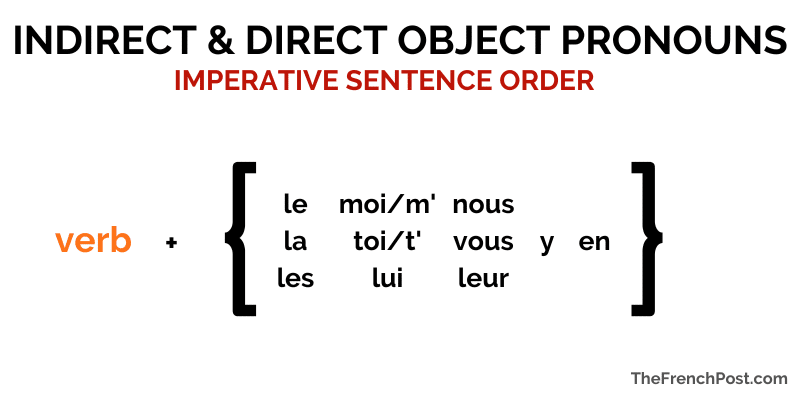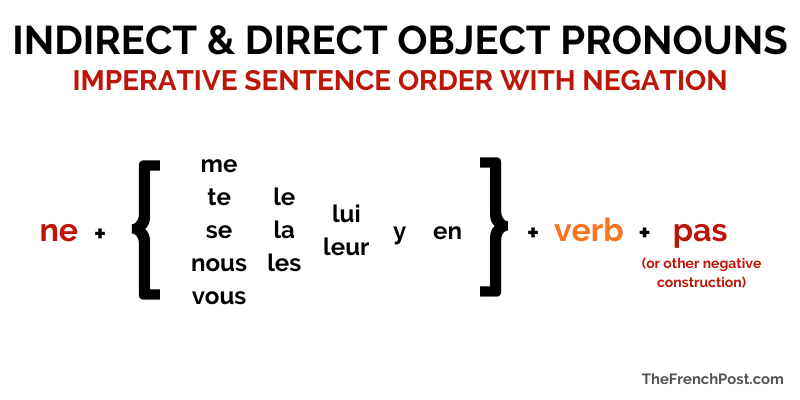
The French imperative tense is the “command” verb tense: it’s how you tell or request that someone do something. In English, there is no special conjugation when we use commands, but the concept is exactly the same in both languages and should be easy for you to pick up on. We’ll focus exclusively on the present tense in this post, because it is by far the most common tense to use the imperative in.
How to form French imperative tense commands
For imperative tense commands, the vous conjugation of the present verb form is generally used. For example:
“Go home.”
“Come with me.”
The equivalents in French would be:
Allez chez vous.
Venez avec moi.
If the person receiving the command is both informal and singular (meaning you would use the tu conjugation instead), you use the tu form of the verb, with the added rule that if the command uses a regular –er verb, you drop the final –s.
For example:
Roule au pas! (“Drive slowly!”)
Viens avec moi. (Venir is not an -er verb, so the final s stays.)
Irregular tu and vous imperative verb forms
Not surprisingly, there are some irregular imperative conjugations for some of the most commonly used French verbs (including être, avoir, and aller).
| Verb | Tu Form | Vous Form |
| être | tu sois | vous soyez |
| avoir | tu aie | vous ayez |
| aller | tu va | vous allez |
| savoir | tu sache | vous sachez |
| vouloir | tu veuille | vous veuillez |
For example:
Soyez gentil avec lui! (“Be nice to him!”)
Sache ce fait d’ici demain (“Know this fact by tomorrow”)
Va chez toi. (“Go home.”)
How to Form French Imperative Tense Suggestions
When you want to convey a suggestion rather than a straight-up command, you use the nous form of the verb. This is the equivalent of saying “Let’s” + verb in English. For example:
“Let’s go home.”
becomes:
Allons chez nous.
Irregular nous imperative verb forms
There are a few important irregular suggestion forms to learn, as well.
| Verb | Nous Form |
| être | nous soyons |
| avoir | nous ayons |
| savoir | nous sachons |
For example:
Soyons plus amicaux aujourd’hui. (“Let’s be friendlier today.”)
Ayons nos chaussures avec nous. (“Let’s have our shoes with us.”)
How to Form French Imperative Tense with object pronouns
The previous examples all either had nouns as direct objects or did not have any direct objects at all. But if you want to use direct or indirect object pronouns like le/la/les or y/en in an imperative sentence, the order changes. The object pronouns will go after the verb, which is how we would say the sentence in English but is not what you would necessarily expect in French.
Review the chart below for the special imperative sentence order of object pronouns. The verb and object pronouns are generally connected with hyphens.

For example:
Fais-le rapidement. (“Do it quickly.”)
Notice in the French imperative chart above that the me and te reflexive pronouns are not present, and are replaced with moi and toi.
Donne-le-moi! (“Give it to me!”)
Apportez-les-moi. (“Bring them to me.”)
However, before y or en, the moi or toi is shortened (which does not usually happen in French with moi and toi) to m’ or t’ instead. This is to prevent two vowel sounds from occurring together like they would if you said something like moi en. For example:
Donnez-m’en quelques-uns. (“Give me some of them.”)
For similar pronunciation reasons, if the the imperative sentence is using the tu form of the verb, and the next word is y or en, you do not drop the final s. That way, there is liason between the verb and the object pronoun.
Nages-y, not Nage-y (“Swim there!”)
Finally, as in other uses of the le/la pronouns, both become l’ in front of vowels. For example:
Mettez-l’y. (“Put it there.”)
How to Form Negative imperative commands
Commands or suggestions not to do something are formed with ne…pas or other negative constructions.
In sentences without object pronouns, the ne and pas just get “sandwiched” on either side of the verb. For example:
N‘allez pas chez vous. (“Don’t go home.”)
Ne viens pas avec moi. (“Don’t come with me.”)
Ne regardons pas ce film. (“Let’s not watch this movie.”)
In sentences with direct or indirect object pronouns, the pronoun order reverts to the “default” object pronoun order, and you don’t use the special hyphen or the unusual “verb first, object pronouns second” order shown with positively worded imperative statements.
The basic form with direct objects is “ne + object pronoun(s) + imperative verb form + pas.”
Ne le faites pas. (“Do not do that.”)
Ne le lui montrez pas. (“Do not show him it.”)
Ne l’ouvrons pas. (“Let’s not open it.”)
The negative imperative object pronoun order is shown below.

Next Steps
We’re done with imperatives! Since we’ve talked about negative sentences, you might want to make sure you fully understand them. They’re much more than just ne…pas. You might also want to start exploring how past tenses work in French.



